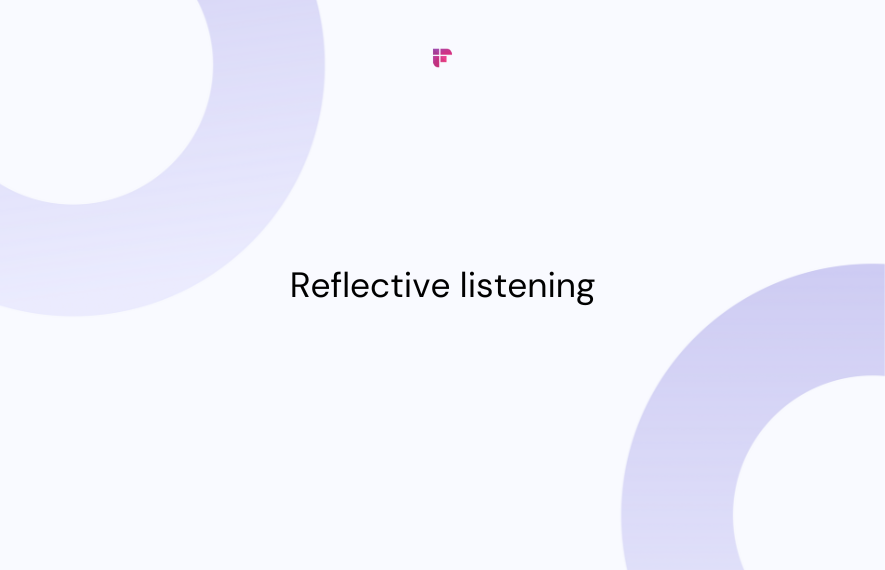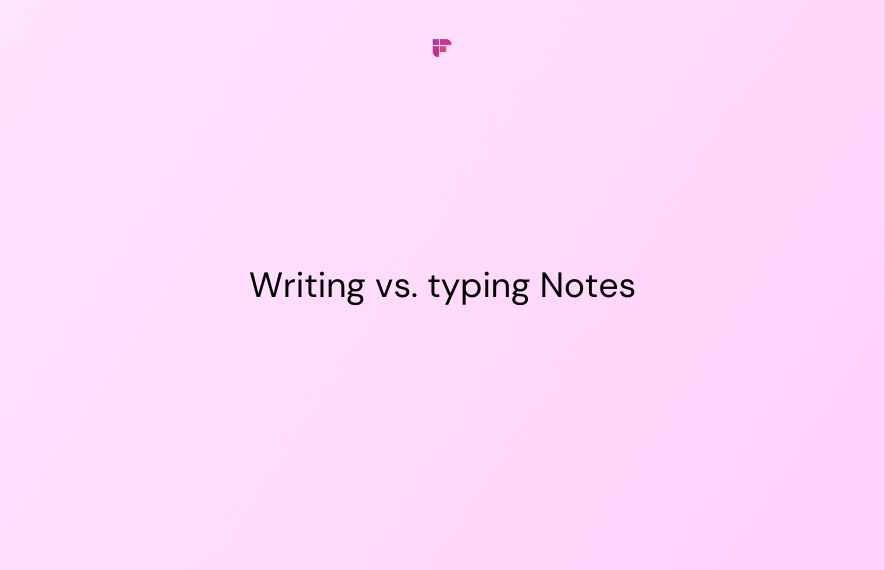The success of any business depends on effective workplace communication, and the numbers tell a compelling story:
- Poor communication results in an annual loss of $62.4 million.
- 86% of employees pinpoint ineffective communication as the leading cause of workplace failures.
- Teams excelling in communication can boost productivity by up to 25%.
It's crystal clear—improving workplace communication isn't just a good idea; it's a vital strategy.
This is where reflective or passive listening steps in as a valuable solution.
Whether talking to clients or working with your team, being good at reflective listening is a skill that makes communication and problem-solving easier.
Curious about what reflective listening is and how it can benefit you?Let's dive in and discover the answers.
What is reflective listening?

What is reflective listening, you ask? In simple terms, reflective listening means repeating what someone said to you. It's like saying back their words to ensure you get it right.
Passive listening involves attentively grasping the speaker's words, tone, and non-verbal cues. Responding includes mirroring their thoughts and emotions and creating deeper understanding and connection.
Reflective listening has three goals:
- To understand better what the other person is saying,
- To help them clear up their thoughts,
- To show them you genuinely care and want to support them.
To follow this concept in a conversation, you need to do two things: repeat what the person said and make sure what you repeat is accurate.
Whether you're talking to a boss, coworker, or someone in your field, always remember that people want to be heard and understood. Good listening ensures they feel seen and truly understood.
Reflective listening definition

The concept of reflective listening finds its roots in psychotherapy and counseling theories, notably Carl Rogers' "client-centered" therapy. This conversational approach aims to assist the speaker in handling or processing a particular matter.
Here's a simple reflective listening definition by the University of New South Wales:
Reflective listening is a communication skill by which students can increase their understanding of other people’s ideas, issues, approaches, and concerns within the group.
Dalmar Fisher, in his work "Communication in Organizations," outlines additional principles of reflective listening:
- Listen more, talk less.
- Respond to personal aspects rather than impersonal, distant, or abstract ones.
- Repeat and clarify what the other person has said instead of asking questions or expressing the listener's feelings, beliefs, or desires.
- Strive to understand the emotions conveyed in the other person's words, not just the facts or ideas.
- Work to grasp the other person's perspective without responding solely from the listener's point of view.
- Respond with acceptance and empathy, avoiding indifference, cold objectivity, or insincere concern.
Reflective listening examples

Take a look at a few reflective listening examples to see how the concept works:
Example 1
- Speaker: "I'm having trouble navigating your website. It's confusing."
- You: "It sounds like you're finding our website navigation confusing. Can you share specific areas you're having difficulty with?"
Example 2
- Speaker: "I'm finding it hard to manage all these productivity logs. Three sheets for different managers take up a lot of my time!"
- You: "So, you feel it would be more efficient if you only had one log to fill out. Do you want me to explore that possibility?"
Example 3
- Speaker: "I'm concerned about the delivery time for my order. Can you provide an update?"
- You: "It seems like you're worried about the delivery time for your order. Let me check and provide you with an update."
Example 4
- Speaker: "I'm struggling to address a client's complaint about our service."
- You: "So, you're dealing with a client complaint and seeking assistance addressing their concerns. Is that what you need help with?"
Example 5
- Speaker: "Can you assist me with this customer email? I usually deal with corporate communications and want to ensure I get the tone right."
- You: "So, you're looking for help on adjusting the language in the message to make it more approachable – is that what you're asking?"
Importance of reflective listening in the workplace

Reflective listening is essential for building understanding and collaboration in the workplace. Here's why it's really important:
1. Enhances understanding
Reflective listening promotes a deep understanding of colleagues' thoughts, ideas, and concerns. It allows individuals to grasp the nuances of messages, reducing the risk of misunderstandings.
2. Fosters positive relationships
Passive listening creates a positive and supportive workplace culture. Employees feel valued and heard, strengthening relationships among team members.
3. Conflict resolution
By acknowledging and reflecting on others' perspectives, reflective listening becomes a powerful tool in resolving conflicts. It encourages open communication, helping to address issues before they escalate.
4. Improved collaboration
Teams that engage in passive listening tend to collaborate more effectively. Clear understanding leads to better teamwork and synergy in achieving common goals.
5. Boosts employee morale
When employees feel heard and understood, it positively impacts their morale and job satisfaction. Reflective listening contributes to a supportive work environment.
6. Effective problem-solving
The technique encourages individuals to express their concerns and ideas openly. This openness facilitates effective problem-solving and innovation within the workplace.
7. Leadership development
Reflective listening is a crucial skill for leaders to build trust and credibility. Leaders who practice passive listening create an environment where employees feel comfortable sharing their thoughts and concerns.
8. Customer satisfaction
Applied in customer interactions, reflective listening ensures a clear understanding of customer needs and concerns. This leads to better customer service and increased satisfaction.
9. Reduced stress and tension
Miscommunication can contribute to workplace stress. Passive listening helps mitigate misunderstandings, reducing tension in the workplace.
10. Cultivates a learning culture
Embracing reflective listening fosters a learning culture where individuals are open to different perspectives. Continuous improvement becomes a natural part of the workplace dynamic.
How to practice reflective listening at workplace?

Let's break down the steps for practicing reflective listening at the workplace:
Step 1: Attentive listening
Resist the urge to respond or interrupt when the other person is speaking. Allow them to express themselves fully, embracing a moment of focused listening.
Step 2: Pause and reflect
Instead of immediately responding, take a moment after the speaker finishes to consider their point. Reflect on the core message, their intentions, and the desired outcome of their communication.
Step 3: Paraphrase
Once you believe you've grasped their message, paraphrase it in your own words. Avoid repeating verbatim; instead, express their point using different language to ensure understanding.
Step 4: Encourage clarification
Allow the speaker to respond by asking questions like "If I understand correctly..." or "Have I got that right?" This step allows them to clarify misinterpretations, expand on their message, or confirm your understanding.
Step 5: Express your response
Now that you clearly understand the other person's perspective, it's your turn to respond. Whether you agree, disagree, or seek additional information, articulate your thoughts, contributing to the ongoing conversation.
Tips to use reflective listening for improving workplace communication

Apart from following the steps, here are some additional tips you can follow to use reflective listening in the workplace:
1. Maintain eye contact
Sustain eye contact to convey attentiveness and show that you are fully engaged in the conversation.
2. Control body language
Ensure open and positive body language, such as nodding and leaning slightly forward, to signal receptiveness and understanding.
3. Limit distractions
Minimize distractions like phone notifications or side conversations to maintain focus on the speaker's message.
4. Use empathetic tones
Use a warm and empathetic tone while responding, conveying understanding, and fostering a supportive atmosphere.
5. Acknowledge emotions
Recognize and acknowledge the emotions expressed by the speaker, demonstrating empathy and validating their feelings.
6. Avoid assumptions
Refrain from making assumptions about the speaker's perspective or intentions; instead, seek clarification to ensure accurate understanding.
7. Be patient
Allow the speaker to express themselves fully without rushing or imposing time constraints, promoting a patient and respectful communication environment.
Improving remote workplace communication with Fireflies.ai

Fireflies.ai is a powerful tool for improving remote workplace communication through its automated meeting transcription and note-taking capabilities.
This tool is a great asset for teams, boosting passive listening. It makes it easy to capture and review important details from conversations, creating a complete record for quick reference.
Here's how Fireflies AI can help improve workplace communication and passive listening:

1. Automated meeting notes
Fireflies AI automatically takes notes, creating a written record for easy reference and supporting passive listening during team meetings.
2. Swift information access
Team members can quickly find insights in transcribed content, saving time and improving workplace efficiency, complementing passive listening.
3. Single source of truth
By capturing every detail, Fireflies AI reduces the risk of losing information and creates a single source of truth, contributing to accurate decision-making and collaborative efforts.
4. Encouraging review and improvement
It allows team members to review discussions using the AI-powered search and its AI meeting assistant, Fred, encouraging reflection and continuous improvement in communication practices. Simply go to Notebook and select the meeting you want to review.
5. Collaborative features
Fireflies enable collaboration by allowing you to add comments, pins, and reactions to specific parts of conversations. You can also create soundbites to share memorable moments.
6. Conversation insight metrics
You can analyze recorded meetings and track metrics like speaker talk time, words spoken per minute, and sentiment to effectively coach teammates, enhancing passive listening and communication skills.
7. Smooth workflow integration
Easily integrate Fireflies.ai with CRM and collaboration apps like Salesforce, Slack, HubSpot, and Zapier for enhanced passive listening. Go to integrations, choose the app, and click connect.
8. AskFred
AskFred is a new feature launched by Fireflies that works as ChatGPT for meetings. Use it to seek answers from recorded meetings, enhancing passive listening for improved comprehension.
Fireflies is crucial for team and client communication. Start for free at $0/month, or subscribe to a paid plan at just $10/month.
💡 Transform workplace communication with Fireflies!
Fireflies enhances workplace communication through automated meeting transcription, note-taking, and ensuring no crucial details are missed in discussions.



![10 Best Note-Taking Apps For Chromebook [Free And Paid]](/blog/content/images/size/w1000/2024/05/Meeting-etiquette-rules-all-professionals-must-follow.png)

